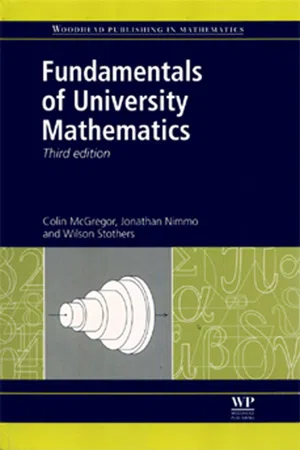Mathematics
Matrix Calculations
Matrix calculations involve performing various operations on matrices, such as addition, subtraction, multiplication, and finding inverses. Matrices are rectangular arrays of numbers or symbols, and these calculations are fundamental in many areas of mathematics, including linear algebra and calculus. They are also widely used in fields like computer graphics, physics, and engineering for solving systems of equations and representing transformations.
Written by Perlego with AI-assistance
Related key terms
Related key terms
1 of 4
Related key terms
1 of 3
7 Key excerpts on "Matrix Calculations"
- eBook - ePub
- Michael Harrison, Patrick Waldron(Authors)
- 2011(Publication Date)
- Routledge(Publisher)
matrix.Definition 1.2.1 A matrix is a rectangular array of scalars called elements (or entries). In this book, scalars will generally be real numbers.Such an array is exemplified in the following general notation for a matrix.Notation 1.2.1 A general matrix A can be written asmA =[=]a 11a 12⋯a1 na 21a 22⋯a2 n⋮ ⋮ ⋮am 1a⋯m 2am n[a]i jNotice the use of a bold upper-case Roman letter for the matrix and the corresponding lower-case letter for its scalar elements. This will be our usual convention when referring to matrices and scalars. Note also the use of subscripts denoting the row and the column to which each element belongs. The number of rows and the number of columns determine the order or dimension of the matrix; here the order is m × n, signifying m rows and n columns and hence mn elements in all. Sometimes it may be useful to make the order explicit by means of a subscript: Am×n. Note further that it is often very useful to denote a matrix by means of its typical element, [aij ]. Thus an efficient way of representing a matrix is to write [aij ]m×n. When m = n, and the number of rows and columns is the same, we say that the matrix is a square matrix.A matrix for which m = 1 is a single row of n elements; this is often called a row vector. Similarly, an m × 1 matrix may be called a column vector. We shall also sometimes refer to m × 1 column vectors as m-vectors, especially from Chapter 5 onwards. Our notation for row and column vectors, respectively, is as follows.Notation 1.2.2 A general row vector r can be written asmr =[]r 1r 2⋯r nNotation 1.2.3 A general column vector c can be written asc =or (c1 ,c2 , ... ,c[]c 1c 2⋮c mm) to economize on space - eBook - ePub
- Colin McGregor, Jonathan Nimmo, Wilson Stothers(Authors)
- 2010(Publication Date)
- Woodhead Publishing(Publisher)
Chapter 11Matrices and Linear Equations
In Chapter 1 , we mentioned the fact that a pair (x, y ) of real numbers can be used to represent a point in the plane. In Chapter 6 , we used such a pair to represent a complex number. This is an example of an important aspect of mathematics— a mathematical object may be interpreted in several different ways. Once we have studied the mathematical objects, we have information which is available in every interpretation.In this chapter we introduce a new mathematical object—the matrix. An m × n matrix is a rectangular array of mn numbers. We can think of the matrix as consisting of m rows , each having n entries , or as n columns , each having m entries. For example,is a 2 × 3 matrix. We regard a matrix as a single entity, to be manipulated as a whole.We define addition on the set of m × n matrices. This operation has properties similar to the addition of real numbers. In particular, there is azero matrix Om × nin the set which behaves like 0 in , i.e.Under certain circumstances, we can define multiplication of matrices. Now some of the results are unfamiliar. For example, there are matrices A and B for which AB ≠ BA.Matrices have many uses in mathematics and its applications. Here we consider just one—the solution of (systems of) linear equations. Looking at such a system leads to the introduction of new operations on matrices. We develop a systematic method for finding all the solutions.In the final sections, we return to the mathematical study of matrices. We consider the existence of matrix inverses. Along the way, we meet the concept of the determinant of a (square) matrix. This is an important topic in its own right and will be used in Chapter 13 in connection with the vector product.11.1 Basic Definitions
Definitions 11.1.1 Let be a number system. A matrix defined over is a rectangular array of elements of . These elements are the entries of the matrix. If a matrix A has m rows (horizontal lines of entries) and n columns (vertical lines), then A is of type m × n or is an m × n bmatrix. - eBook - ePub
- Graham Doggett, Martin Cockett(Authors)
- 2015(Publication Date)
- Royal Society of Chemistry(Publisher)
11 Working with Arrays II: Matrices and Matrix Algebra In the previous chapter, we saw how determinants are used to tackle problems involving the solution of systems of linear equations. In general, the branch of mathematics which deals with linear systems is known as linear algebra, in which matrices and vectors play a dominant role. In this chapter we shall explore how matrices and matrix algebra are used to address problems involving coordinate transformations, as well as revisiting the solution of sets of simultaneous linear equations. Vectors are explored in Chapter 12. Matrices are two-dimensional arrays (or tables) with specific shapes and properties: Their key property is that they give us a formalism for systematically handling sets of objects – called elements – which, for example, can be numbers, chemical property values, algebraic quantities or integrals. Superficially, matrices resemble determinants, insofar as they are constructed from arrays of elements. However, as we shall see, they are really quite distinct from one another - eBook - ePub
- Fletcher Dunn, Ian Parberry(Authors)
- 2011(Publication Date)
- A K Peters/CRC Press(Publisher)
Chapter 4Introduction to Matrices
Unfortunately, no one can be told what the matrix is. You have to see it for yourself.— Morpheus in The Matrix (1999)Matrices are of fundamental importance in 3D math, where they are primarily used to describe the relationship between two coordinate spaces. They do this by defining a computation to transform vectors from one coordinate space to another.This chapter introduces the theory and application of matrices. Our discussion will follow the pattern set in Chapter 2 when we introduced vectors: mathematical definitions followed by geometric interpretations.- Section 4.1 discusses some of the basic properties and operations of matrices strictly from a mathematical perspective. (More matrix operations are discussed in Chapter 6 .)
- Section 4.2 explains how to interpret these properties and operations geometrically.
- Section 4.3 puts the use of matrices in this book in context within the larger field of linear algebra.
4.1 Mathematical Definition of Matrix
In linear algebra, a matrix is a rectangular grid of numbers arranged into rows and columns . Recalling our earlier definition of vector as a one-dimensional array of numbers, a matrix may likewise be defined as a two-dimensional array of numbers. (The “two” in “two-dimensional array” comes from the fact that there are rows and columns, and should not be confused with 2D vectors or matrices.) So a vector is an array of scalars, and a matrix is an array of vectors.This section presents matrices from a purely mathematical perspective. It is divided into eight subsections. - eBook - ePub
Introduction to Linear Algebra
A Primer for Social Scientists
- Gordon Mills(Author)
- 2017(Publication Date)
- Routledge(Publisher)
For example, the b ij might represent the numbers of people living in grid areas into which the entire area of a country had been divided. For such a grid approach, it would be natural to represent the results in a rectangular array, in which one subscript referred to the latitude and the other to the longitude of each grid area. Now suppose that we wished to estimate car ownership in each grid area by classifying each area according to socio-economic characteristics, and then applying car ownership coefficients (so many cars per 1000 of population) where the coefficients vary according to the socio-economic classification. The complete set of such coefficients, ready for application, might be stored as a rectangular array, the a ij. These could then be multiplied into the b ij (in accordance with our present concept of the multiplication operation) to produce the matrix C whose elements c ij represent estimated numbers of cars owned by persons living in each grid area. While this operation is both respectable and useful in some applications, it is not the one which is conventionally described as matrix multiplication; accordingly we would need another name for it if we wished to make frequent reference to it. Let us now turn to the customary definition of matrix multiplication, which has little to do with the concept of a matrix as an array of data. Instead, it is chosen because it is very useful in the manipulation and solution of systems of simultaneous equations ; this use will be illustrated later. The basic idea is to multiply the elements in rows of the first matrix into the elements of columns in the second matrix. Thus the operation is defined only when the first matrix has the same number of columns as the second matrix has rows (thereby ensuring that a row of the first matrix has the same number of elements as a column of the second matrix) - Alexander Basilevsky(Author)
- 2013(Publication Date)
- Dover Publications(Publisher)
Chapter 3Matrices and Systems of Linear Equations
3.1 Introduction
A vector is an ordered array of numbers that determine the magnitude and direction of the vector. A further generalization is that of a matrix A = (a ij ) denoted as the n × k rectangular array(3.1)with typical element a ij (i = 1,2,...,n ; j = 1, 2, ... ,k ). A vector can therefore also be thought of as a n × 1 column or a 1 × k row matrix. Alternatively, a matrix may be viewed as a collection of n row vectorsor k column vectors(3.2)where(3.3)for i = 1,2,...,n and j = 1 ,2 ,...,k .Matrices derive their importance in research owing to the fact that most of the data in the social, economic, geographical, bioecological, and medical or health sciences can be represented as rectangular arrays of real numbers, where columns, say, represent the measurements or variables and rows represent a multivariate sample of the objects, persons, or land areas for which the measurements are made. Treating such tables as matrices enables the research worker to carry out complex data manipulation within a unified context, independently of the size of the data. Analyses of large data sets have become common with the widespread availability of high-speed electronic computers.3.2 General Types of Matrices
Before considering matrix manipulations such as addition, multiplication, and inversion, we first examine certain special forms that matrices can assume. In what follows, the zero matrix, which contains zeros as elements, is denoted by 0. Generally, a matrix can contain zero elements, nonzero elements, or both. The zero elements are at times distributed in particular patterns giving rise to specific matrix forms.3.2.1 Diagonal Matrix
One of the simplest and most commonly occurring matrices is the diagonal matrix. Generally speaking, a square n × n matrix A = (a ij ) is said to be in diagonal form when all the elements of A- eBook - ePub
Numerical Analysis for Engineers
Methods and Applications, Second Edition
- Bilal Ayyub, Richard H. McCuen(Authors)
- 2015(Publication Date)
- Chapman and Hall/CRC(Publisher)
2Matrices
2.1 Introduction
2.1.1 Definition of a Matrix
What is a matrix? Simply stated, it is a rectangular array of numbers. Each column has the same number of values r , where r is the number of rows. Similarly, each row has the same number of values c , where c is the number of columns. It is not necessary for the number of rows to equal the number of columns. A rectangular matrix with three rows and two columns is shown in Figure 2.1 a. A capital letter will be used to denote the name of the array; the values contained in the matrix are called elements and are denoted asaij, where the lowercase letter a is used to indicate the element of matrix A , i refers to the row, and j refers to the column. Figure 2.1 b shows a matrix with r rows and c columns; thus, element b 57 refers to the value in the fifth row and seventh column of matrix B .FIGURE 2.1 Example matrices.2.1.2 Formation of a Matrix
What produces a matrix? Matrices are useful for representing data sets. Figure 2.2 shows a data matrix of concentrations of the following three water-quality indicators from five wells: hardness (H), alkalinity (A), and pH. The matrix can be represented with the well number either as the row variable (Figure 2.2 a) or the column variable (Figure 2.2 b). The form of the matrix depends on style or use. It is easier to compare the values of pH by reading down the columns (Figure 2.2 a) than across them (Figure 2.2 b), so Figure 2.2
Index pages curate the most relevant extracts from our library of academic textbooks. They’ve been created using an in-house natural language model (NLM), each adding context and meaning to key research topics.
Explore more topic indexes
Explore more topic indexes
1 of 6
Explore more topic indexes
1 of 4






